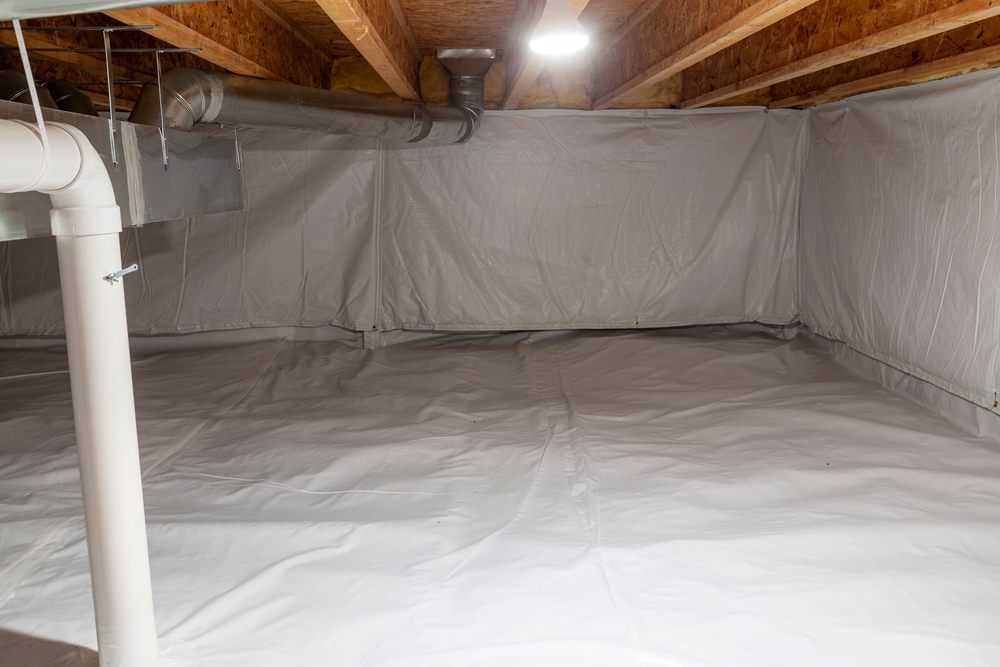Ever wondered what’s going on beneath your home’s floor? You probably know about basements or concrete slabs, but what is a crawlspace? It’s a key part of your home’s foundation that can affect your home’s overall health, so understanding it could save you from future problems.
This area beneath your house has several important uses, although many people don’t know much about it. A crawlspace offers a buffer between your living spaces and the ground. This is key for maintaining your home.
Understanding Crawlspaces: More Than Just Empty Space
A crawlspace is a low, unfinished area under a house. It provides access to essential systems like plumbing and wiring. This makes maintenance easier.
This area is usually too small to stand in, requiring people to crouch or crawl to enter. Crawlspaces provide a barrier between the earth and your home’s first floor. This design helps manage moisture and provides easier access for repairs.
In regions with high humidity, these spaces help protect the structure from moisture buildup. Construction is also often less expensive than digging a full basement.
Why Some Homes Have Crawlspaces
You might ask, “If basements exist, why choose a smaller space?” Cost and location are the primary factors.
Homes built near marshes often use crawlspaces. This design is popular in the southeastern United States, due to high moisture levels.
A crawl space helps prevent moisture-related problems under the house, avoiding costly repairs. It also helps improve indoor air quality by keeping ground moisture from evaporating into the home.
The Guts of Your Home: What’s Inside?
A crawlspace isn’t empty; it’s where many of your home’s important systems operate. Plumbing lines often run through it. Electrical wiring also connects to various parts of the house from here.
Having these systems accessible, yet out of sight, is very useful. If a leak occurs, you can quickly access the pipe. This setup allows for easier repairs and maintenance.
Crawlspace Construction: Building a Solid Foundation
Creating a crawlspace requires skill and knowledge. A professional can find the optimal location for stability.
First, crews dig trenches below the frost line. The walls are made of concrete. Next, footings and block walls provide support.
The entry must meet specific size requirements. The standard ensures an 18-inch height and 24-inch width. This allows for safe and adequate access for inspections and repairs.
Vapor Barriers: A Shield Against Moisture
A common way to handle moisture is by installing a vapor barrier. This barrier acts as a protective layer.
These barriers are large plastic sheets that cover the dirt. Installing crawl space vapor barriers helps to significantly reduce moisture under your home. This protects the foundation and improves indoor air quality.
By preventing ground moisture evaporation, vapor barriers help avoid mold and structural damage.
Encapsulation: The Ultimate Moisture Solution
If a vapor barrier isn’t enough, full crawl space encapsulation might be necessary. This is like covering the entire area in a protective shell.
This approach can greatly reduce energy use. Encapsulation upgrades your crawlspace into a semi-conditioned area.
This comprehensive method helps maintain a consistent temperature and reduces the risk of moisture and pest issues.
Maintaining a Healthy Crawlspace
Your crawlspace is often ignored since it’s out of sight. Regular check-ups are still important, however.
Use a flashlight to inspect the area twice a year. Check thoroughly for signs of wood rot and foundation cracks that need repair. Also, look for any pest activity or damage.
Addressing Potential Problems
Moisture problems in your crawlspace are common issues that many homeowners deal with. Check the soil around your house, as shifts can cause problems.
As your house settles, the soil shifts. This can reveal weaknesses in the building’s structure. Addressing moisture early prevents bigger issues.
Excess moisture can lead to mold growth, wood rot, and attract pests, so keeping the area dry is essential.
Pest Prevention
Even with cleaning, insects can invade, causing more problems. Sealing cracks helps prevent this. Contacting a local exterminator may be necessary.
Pests like termites and rodents can cause significant damage. Regular inspections and sealing entry points keep them out.
Keeping the crawl space clean and dry also makes it less appealing to pests.
Energy Savings and Crawlspaces
Are your energy costs high? Insulation can help. Adding insulation between your floor joists is a good idea.
Your crawlspace needs attention if it’s impacting utility bills. If a heating and cooling system runs constantly, better insulation is needed. Properly insulating the crawlspace helps maintain a steady indoor temperature.
Consider insulation and sealing as part of a planned crawl space project. Homes in colder regions often need these updates more frequently. This reduces energy loss and lowers heating and cooling costs.
Vented vs. Encapsulated Crawl Spaces: A Critical Choice
There are two main types of crawl space foundations. Here’s how they compare:
| Feature | Vented Crawl Space | Encapsulated Crawl Space |
|---|---|---|
| Airflow | Open vents allow free air flow | Sealed off from outside air |
| Moisture Control | Prone to humidity and moisture | Better control with vapor barrier, dehumidifier |
| Pest Control | More vulnerable to pests | Better prevention due to sealing |
| Energy Efficiency | Less efficient | More efficient with better insulation |
| Maintenance | Needs regular checks for moisture and pests | Lower maintenance once encapsulated |
Vented crawl spaces were once thought to be the best approach, with openings for air circulation. But, open crawl space vents can let in moist air, leading to problems.
Encapsulated, or conditioned, crawl spaces are sealed from outside elements. By isolating this area, the crawlspace stays dry.
This also helps improve indoor air quality and energy efficiency by creating a more controlled environment.
Conclusion
Maintaining your crawlspace means protecting your entire home. Understanding “what is a crawlspace” is essential. You now understand the important role your crawlspace has.
Proper care keeps the structure safe, making your home comfortable and durable. Regular checks of the crawlspace can enhance your home experience.


